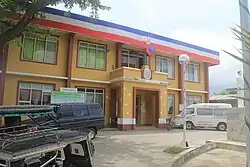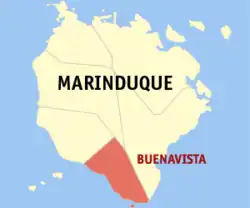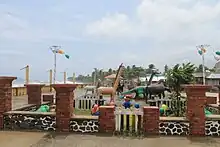Buenavista | |
|---|---|
| Municipality of Buenavista | |
 Municipal Hall | |
 Flag  Seal | |
| Nickname: Malindig Country | |
 Map of Marinduque with Buenavista highlighted | |
OpenStreetMap | |
.svg.png.webp) Buenavista Location within the Philippines | |
| Coordinates: 13°15′N 121°57′E / 13.25°N 121.95°E | |
| Country | Philippines |
| Region | Mimaropa |
| Province | Marinduque |
| District | Lone district |
| Founded | November 9, 1918 |
| Barangays | 15 (see Barangays) |
| Government | |
| • Type | Sangguniang Bayan |
| • Mayor | Eduard L. Siena |
| • Vice Mayor | David G. Vitto |
| • Representative | Lord Allan Jay Q. Velasco |
| • Municipal Council | Members |
| • Electorate | 16,105 voters (2022) |
| Area | |
| • Total | 81.25 km2 (31.37 sq mi) |
| Elevation | 65 m (213 ft) |
| Highest elevation | 1,174 m (3,852 ft) |
| Lowest elevation | 0 m (0 ft) |
| Population (2020 census)[3] | |
| • Total | 26,043 |
| • Density | 320/km2 (830/sq mi) |
| • Households | 6,258 |
| Economy | |
| • Income class | 4th municipal income class |
| • Poverty incidence | 19.65 |
| • Revenue | ₱ 102.3 million (2020) |
| • Assets | ₱ 330.7 million (2020) |
| • Expenditure | ₱ 76.25 million (2020) |
| • Liabilities | ₱ 69.7 million (2020) |
| Service provider | |
| • Electricity | Marinduque Electric Cooperative (MARELCO) |
| Time zone | UTC+8 (PST) |
| ZIP code | 4904 |
| PSGC | |
| IDD : area code | +63 (0)42 |
| Native languages | Tagalog |
Buenavista, officially the Municipality of Buenavista (Tagalog: Bayan ng Buenavista), is a 4th class municipality in the province of Marinduque, Philippines. According to the 2020 census, it has a population of 26,043 people.[3]
Buenavista is 30 kilometres (19 mi) from Boac.
Etymology
The town was named "Buenavista" by Don Cornelio Sadiua, due to its "good view." Its former name was Sabang, which is the river that runs through it. The majority of Buenavistans trace their ancestry to the Don Cornelio Sadiua family.
History
In 1942, the Japanese Imperial forces landed in Buenavista at Patay Ilog before making their way to the capital. Due to its rugged terrain, relative isolation, and fierce pro-American sentiment, Buenavista was the headquarters for the resistance movement. Japanese forces and the Resistance and guerrillas frequently engaged in skirmishes within the town borders. Occupying Japanese forces burned the school and municipal building, after holding captives composed a member from each Buenavista family. Guerrilla forces eventually re-captured the town.
The 'Libas Ambush, known locally as Pinag Labanan, was a joint guerrilla-Buenavistan effort in which Filipino guerrillas and Buenavistans ambushed and killed a troop of Japanese soldiers. After which the Japanese commandant issued a proclamation that for 1 Japanese soldier killed by the Filipinos in Buenavista, 10 Filipinos will die within a 5-mile radius.
In spite of the Japanese threats the Buenavistans continued their fight against Japanese occupation throughout the war, including rescuing and hiding several the combined Filipino and American military personnel during the war. One such rescue occurred shortly after the fall of Bataan, when the lighthouse keeper found an American seaman hiding among the shoreline rocks. These rescued Filipinos and Americans were clothed, fed and hidden by the Buenavistans, even though they risked execution if the Japanese found out about it.
In 1945, the combined U.S. and Allied Philippine Commonwealth military forces landed at Caigangan beach in Buenavista and attacked from the Japanese Imperial forces in the Battle of Marinduque. The Buenavista Campaign was the first major offensive fought during the Battle of Marinduque. It culminated in a bloody firefight between the Japanese and a joint Allied- Filipino guerrilla offensive. The Japanese, who were headquartered in the Municipal building and elementary school, were soundly defeated.
Buenavista was chosen as the headquarters of the 5th Infantry Division of the Philippine Commonwealth Army and the U.S. Army Signal Corps due to their record of anti-Japanese actions during the war. The U.S. Army Signal Corps and the 5th Infantry Division of the Philippine Commonwealth Army were quartered in Pablo Pe's bodega in the town.
The longest-serving mayor was Recaredo Sarmiento. His term was interrupted during World War II. The first Chinese-Filipino mayor was Wilfredo Sadiua Pe.
Geography
Barangays
Buenavista is politically subdivided into 15 barangays. [5] Each barangay consists of puroks and some have sitios.
Climate
| Climate data for Buenavista, Marinduque | |||||||||||||
|---|---|---|---|---|---|---|---|---|---|---|---|---|---|
| Month | Jan | Feb | Mar | Apr | May | Jun | Jul | Aug | Sep | Oct | Nov | Dec | Year |
| Mean daily maximum °C (°F) | 26 (79) |
28 (82) |
29 (84) |
31 (88) |
31 (88) |
30 (86) |
29 (84) |
29 (84) |
29 (84) |
29 (84) |
28 (82) |
27 (81) |
29 (84) |
| Mean daily minimum °C (°F) | 22 (72) |
22 (72) |
22 (72) |
23 (73) |
25 (77) |
25 (77) |
25 (77) |
25 (77) |
25 (77) |
24 (75) |
23 (73) |
23 (73) |
24 (75) |
| Average precipitation mm (inches) | 115 (4.5) |
66 (2.6) |
55 (2.2) |
39 (1.5) |
164 (6.5) |
282 (11.1) |
326 (12.8) |
317 (12.5) |
318 (12.5) |
192 (7.6) |
119 (4.7) |
173 (6.8) |
2,166 (85.3) |
| Average rainy days | 13.6 | 9.4 | 10.4 | 10.5 | 21.1 | 26.0 | 29.0 | 27.6 | 27.5 | 23.1 | 16.7 | 16.1 | 231 |
| Source: Meteoblue[6] | |||||||||||||
Demographics
| Year | Pop. | ±% p.a. |
|---|---|---|
| 1939 | 4,354 | — |
| 1948 | 5,040 | +1.64% |
| 1960 | 7,303 | +3.14% |
| 1970 | 10,463 | +3.66% |
| 1975 | 11,787 | +2.42% |
| 1980 | 13,025 | +2.02% |
| 1990 | 15,495 | +1.75% |
| 1995 | 17,358 | +2.15% |
| 2000 | 19,271 | +2.27% |
| 2007 | 21,018 | +1.20% |
| 2010 | 23,111 | +3.51% |
| 2015 | 23,988 | +0.71% |
| 2020 | 26,043 | +1.63% |
| Source: Philippine Statistics Authority[7][8][9][10] | ||
In the 2020 census, the population of Buenavista, Marinduque, was 26,043 people,[3] with a density of 320 inhabitants per square kilometre or 830 inhabitants per square mile.
Economy
Locally crafted products include:
- Kalamay-hati: A type of coconut jam made from coconut cream and sugar or molasses
- Maja blanca: A type of coconut pudding
- Suman: A dessert/snack made of sticky rice and coconut steamed in leaves.
- Puto: A steamed rice cake.
- Bagoong: A traditional fish paste made using fresh local/sustainable ingredients.
Tourism

- The Palengke Seaside Cultural Arts and Entertainment Pavilion: A local gathering place for Buenavista events, parties, and exhibitions.
- Malbog Hot Springs: Located in the Malbog district. These are hot sulfur springs, heated by the volcanic Mount Malindig. They reputedly have therapeutic and healing properties.
- Elephant Island (previously Isla Perro): Located off the coast of Buenavista in the shadow of Malindig. In the 1970s the island was for sale at a price of 3000 pesos. In 2009, Bellarocca Island Resort and Spa opened in this island.
- Inuman Bato (Drinking Rock): Located in Suk'an district. It is a tidal pool on the beach that is submerged in the sea during high tide. At low tide, the pool is filled with drinkable, fresh water. It was reportedly featured in the popular "Ripley's Believe It or Not!" newspaper serial during the 1950s.
- Pablo Pe's Bodega: Located on Don Cornelio Street, next to the Pe House. This humble structure served as the headquarters of the United States Army Signal Corps during the Liberation.
Events
- Santo Nino Festival: A four-day festival of food, fun and family-friendly activities and events. It is held annually in January.
- Flores de Mayo: This celebration is held yearly from May 1 through May 31. It is in honor of the Blessed Virgin Mary. The children of Buenavista give gifts of bouquets and wreaths of native flowers to the Blessed Virgin.
Government
List of former local chief executives
- Agaton Sarmiento ------- 1918-1925
- Ciriaco Arevalo -------- 1925-1931
- Vitaliano Salvacion ---- 1931-1934
- Cesar Nepomuceno ------- 1934-1937
- Jose Salvacion -------------- 1934-1941
- Teofisto Jamolin ------------ 1941-1944
- Jose Sarmiento -------------- 1944-1945
- Jose Salvacion -------------- 1945-1946
- Recaredo Sarmiento ---------- 1946-1947
- Recaredo Sarmiento ---------- 1947-1956
- Vitaliano Salvacion --------- 1956-1958
- Josefina Sadiwa ------------- 1958-1959
- Claudio Mabunga ------------- 1959-1967
- Wilfredo S. Pe -------------- 1967-1972
- Wilfredo S. Pe -------------- 1972-1980
- Renato S. Madrigal ---------- 1980
- Ofelia S. Madrigal (OIC) ----- 1980-1988
- Ofelia S. Madrigal ---------- 1988-1992
- Wilfredo S. Pe -------------- 1992-1995
- Ofelias S. Madrigal --------- 1995
- Russel S. Madrigal ---------- Present
Education
Tertiary
- Marinduque Victorians College
Secondary
- Buenavista National High School
- Buenavista National High School - Bagacay Annex
- Buenavista National High School - Daykitin Annex
- Buenavista National High School - Lipata-Tungib Annex
- Buenavista National High School - Sihi Annex
- Yook National High School
Primary
- Bagacay Elementary School
- Bagtingon Elementary School
- Bancoro Public School
- Bicas-Bicas Elementary School
- Binunga Public School
- Buenavista Central School
- Caigangan Elementary School
- Daat Public School
- Daykitin Elementary School
- Libas Elementary School
- Lipata Elementary School
- Malbog Elementary School
- Pag-Asa Elementary School
- Sihi Elementary School
- Timbo Elementary School
- Tungib Elementary School
- Yook Elementary School
Private schools:
- Good Shepherd Diocesan School IFI
- Holy Child Jesus Parochial School
References
- ↑ Municipality of Buenavista | (DILG)
- ↑ "2015 Census of Population, Report No. 3 – Population, Land Area, and Population Density" (PDF). Philippine Statistics Authority. Quezon City, Philippines. August 2016. ISSN 0117-1453. Archived (PDF) from the original on May 25, 2021. Retrieved July 16, 2021.
- 1 2 3 Census of Population (2020). "Mimaropa". Total Population by Province, City, Municipality and Barangay. Philippine Statistics Authority. Retrieved 8 July 2021.
- ↑ "PSA Releases the 2018 Municipal and City Level Poverty Estimates". Philippine Statistics Authority. 15 December 2021. Retrieved 22 January 2022.
- ↑ "Province: Marinduque". PSGC Interactive. Quezon City, Philippines: Philippine Statistics Authority. Retrieved 12 November 2016.
- ↑ "Marinduque: Average Temperatures and Rainfall". Meteoblue. Retrieved 28 April 2020.
- ↑ Census of Population (2015). "Region IV-B (Mimaropa)". Total Population by Province, City, Municipality and Barangay. Philippine Statistics Authority. Retrieved 20 June 2016.
- ↑ Census of Population and Housing (2010). "Region IV-B (Mimaropa)" (PDF). Total Population by Province, City, Municipality and Barangay. National Statistics Office. Retrieved 29 June 2016.
- ↑ Censuses of Population (1903–2007). "Region IV-B (Mimaropa)". Table 1. Population Enumerated in Various Censuses by Province/Highly Urbanized City: 1903 to 2007. National Statistics Office.
{{cite encyclopedia}}: CS1 maint: numeric names: authors list (link) - ↑ "Province of Marinduque". Municipality Population Data. Local Water Utilities Administration Research Division. Retrieved 17 December 2016.
- ↑ "Poverty incidence (PI):". Philippine Statistics Authority. Retrieved December 28, 2020.
- ↑ "Estimation of Local Poverty in the Philippines" (PDF). Philippine Statistics Authority. 29 November 2005.
- ↑ "2003 City and Municipal Level Poverty Estimates" (PDF). Philippine Statistics Authority. 23 March 2009.
- ↑ "City and Municipal Level Poverty Estimates; 2006 and 2009" (PDF). Philippine Statistics Authority. 3 August 2012.
- ↑ "2012 Municipal and City Level Poverty Estimates" (PDF). Philippine Statistics Authority. 31 May 2016.
- ↑ "Municipal and City Level Small Area Poverty Estimates; 2009, 2012 and 2015". Philippine Statistics Authority. 10 July 2019.
- ↑ "PSA Releases the 2018 Municipal and City Level Poverty Estimates". Philippine Statistics Authority. 15 December 2021. Retrieved 22 January 2022.